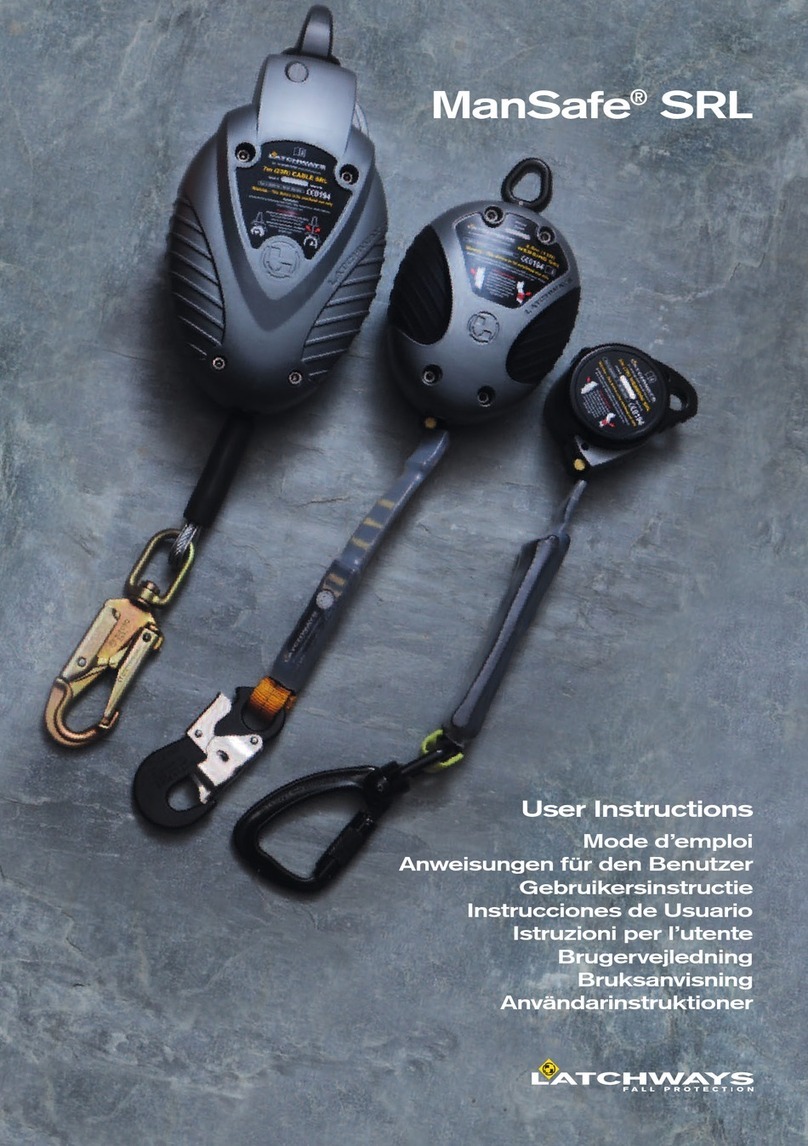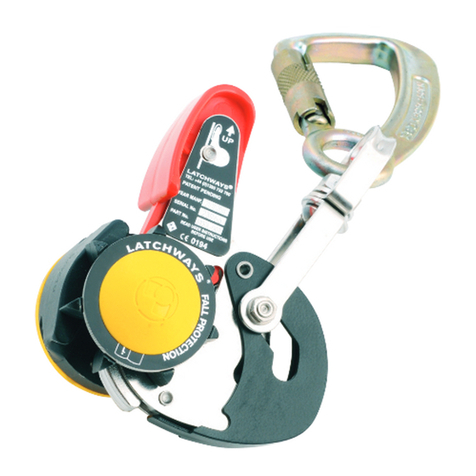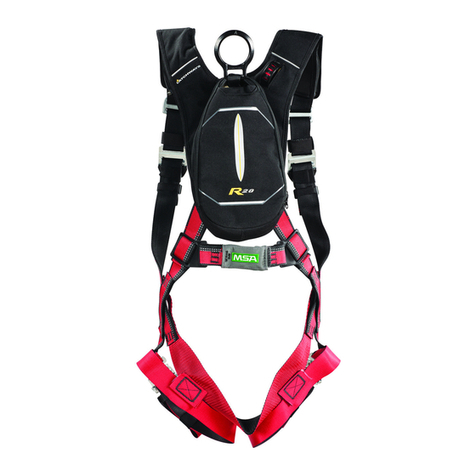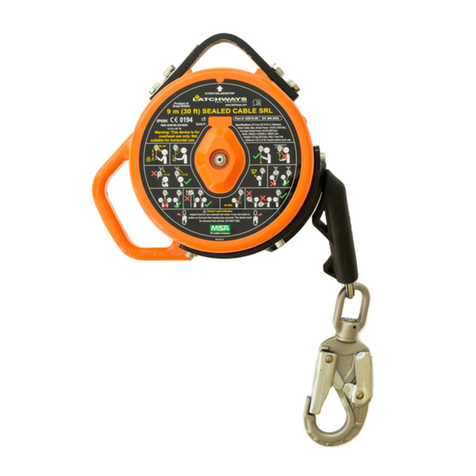
MSA Latchways®Tie-back Mini PFL
User Instructions
1. General information This information is to be used in conjunction with
MSA Latchways PFL User Instructions.
2. Intended use and product limitations The Latchways Tie-back Mini
PFL is uniquely engineered to allow the User to tie-off safely to a suitable
anchorage. The MSA Latchways TwinLink connector allows two Latchways
Tie-back Mini PFLs to be connected to the User for 100% tie-off.
The Latchways Tie-back Mini PFL is designed with heavy duty, abrasion
resistant, webbing and a snap hook. This allows connection back to the
webbing lanyard, in a choking fashion. The Latchways Tie-back Mini PFL
has a 1.8 m (6ft) retractable lanyard and a 0.9 m (3 ft) tie-back sheathed
lanyard. This gives a working length of between 2.7 m (9 ft) and 1.8 m (6
ft) dependent upon the method of attaching.
ALatchwaysTie-backMiniPFLhasbeenspecicallydesignedtouseina
choking fashion, DO NOT attempt this type of connection with other products.
The Latchways Tie-back Mini PFL is designed for single user only within the
weight range 60 - 141 kg (130 - 310 lbs) (including tools). Suitable for use
up to 181 kg (400 lbs) (including tools) when used under OSHA regulations
only.
Latchways Tie-back Mini PFLs shall not be used in Leading Edge or
MEWP applications.
3. Installation and use Ensure that the Latchways Tie-back Mini PFL is
suitable for use by completing the pre-use checks and additionally checking
that the sheathed lanyard and snap hook are present and of a suitable
condition.
Select an approved mounting location that meets all anchorage
requirements, such as an I-beam. Anchorages must be free of sharp edges
or abrasive surfaces. Anchorages must be capable of supporting 5,000
lbs (22.2 kN) (CSA Z259.15) per worker or meet OSHA requirements for a
safety factor of two.
Attach the body of the Latchways Tie-back Mini PFL to the back D-ring of
the full-body harness using the attached connector of the device.
Wrap the lanyard around the anchorage and connect the snap hook to the
lanyard in a choking fashion. Ensure that the lanyard is captured in the snap
hook and the gate of the snap hook is not obstructed in any way. Verify that
the snap hook is completely closed and locked. Ensure that the lanyard is
pulled tight providing a secure loop around the anchorage. (Figure 1)
Latchways Tie-back Mini PFL shall only be attached to the webbing below
the stitched red arrow. Never attach the Latchways Tie-back Mini PFL snap
hook above the stitched red arrow. (Figure 1)
Never connect the snap hook of one Latchways Tie-back Mini PFL to the
lanyard of another Latchways Tie-back Mini PFL or other connecting device.
4. Fall clearance Please refer to the ‘Acceptable anchor locations’ (Table
3) within the MSA Latchways PFL User Instructions when attaching to
large (leaving <400 mm of the sheathed lanyard - Figure 2a) anchorage
locations. When using on small (leaving >400 mm of the sheathed lanyard
- Figure 2b) anchorage locations, or directly attached to a suitable anchor
point, the device shall be used in accordance with Table 1 ‘Suitable anchor
locations B’. The requirements are different due to the increased potential
free fall distance when anchored to a small anchorage location.
5. Cleaning maintenance and storage Clean, maintain and store as per
Latchways PFLs.
6. Pre-use checks and periodic examination In addition to Latchways PFL
pre-use checks inspect the sheath for excessive damage. The Sheathed
lanyard shall have no gaps that expose
the webbing beneath.
MSA Latchways®Tie-back Mini PFL
Instrucciones de usuario
1. Información general Esta información debe utilizarse junto con las
instrucciones para el usuario del MSA Latchways PFL.
2. Uso previsto y limitaciones del producto El Latchways Tie-back Mini
PFL cuenta con un diseño exclusivo que permite al usuario sujetarse
de forma segura a un anclaje apropiado. El conector MSA Latchways
TwinLink permite conectar dos Latchways Tie-back Mini PFL al usuario
para conseguir una sujeción total.
El Latchways Tie-back Mini PFL cuenta con una banda textil de alto rendimiento
y resistente a la abrasión y un enganche rápido. Esto permite conectarlo
al elemento de amarre de la banda textil formando una lazada corrediza.
El Latchways Tie-back Mini PFL (Mini PFL de autoengache de Latchways)
cuenta con un elemento de amarre retráctil de 1,8 m (6 ft) y con un elemento
de amarre revestido de autoenganche de 0,9 m (3 ft) lo que proporciona una
longitud de trabajo de entre 2,7 m (9 ft) y 1,8 m (6 ft) en función del método de
acoplamiento.
ElLatchwaysTie-backMiniPFLsehadiseñadoespecícamentepara
utilizarse formando una lazada corrediza. NO intente este tipo de conexión
con otros productos.
El Latchways Tie-back Mini PFL está diseñado para un solo usuario con un
peso de entre 60 y 141 kg (130-310 lbs) (herramientas incluidas). Apto para
usarse con un peso de hasta 181 kg (400 lbs) (herramientas incluidas) solo
cuando se utiliza de conformidad con los reglamentos OSHA.
El Latchways Tie-back Mini PFL no debe utilizarse en aplicaciones
Leading Edge ni MEW.
3. Instalación y uso Compruebe que el Latchways Tie-back Mini PFL sea
apto para usarse. Para ello, lleve a cabo las inspecciones anteriores
alusoyverique,además,queelelementodeamarrerevestidoyel
enganche rápido estén presentes y en buenas condiciones, es decir, sin
interrupciones.
Seleccione un lugar de montaje aprobado que cumpla todos los requisitos
de anclaje, por ejemplo, una viga en I. Los anclajes no deben tener bordes
aladosnisuperciesabrasivas.Losanclajesdebenpodersoportarun
peso de 5000 lbs (22,2 kN) (CSA Z259.15) por trabajador o cumplir los
requisitosOSHAparauncoecientedeseguridaddedos.
Sujete el cuerpo del Latchways Tie-back Mini PFL a la argolla en D trasera
del arnés anticaída, utilizando para ello el conector del dispositivo que se
incluye.
Envuelva el elemento de amarre alrededor del anclaje y conecte el
enganche rápido al elemento de amarre formando una lazada corrediza.
Compruebe que el elemento de amarre se sujeta en el enganche rápido
yqueeljadordelengancherápidonoestéobstruido.Veriquequeel
enganche rápido esté completamente cerrado y bloqueado.
Compruebe que el elemento de amarre esté bien tensado para lograr un
nudo seguro alrededor del anclaje. (Figura 1)
El Latchways Tie-back Mini PFL solo debe sujetarse a la banda textil por debajo
delaecharojacosida.NosujetenuncaelengancherápidodelLatchwaysTie-
backMiniPFLporencimadelaecharojacosida.(Figura 1)
No conecte nunca el enganche rápido de un Latchways Tie-back Mini
PFL al elemento de amarre de otro Latchways Tie-back Mini PFL ni a otro
dispositivo de conexión.
4. Distancia de caída Consulte las «Ubicaciones de anclaje aceptables»
(tabla 3) de las instrucciones para el usuario del MSA Latchways PFL
cuando lo sujete a lugares de anclaje grandes (dejando una distancia
< 400 mm en relación con el elemento de amarre revestido, gura 2a).
Cuando lo utilice en lugares de anclaje pequeños (dejando una distancia
> 400 mm en relación con el elemento de amarre revestido, gura 2b)
o directamente sujeto a un punto de anclaje adecuado, el dispositivo
deberá utilizarse de conformidad con la tabla 1 «Ubicaciones de anclaje
adecuadas B». Los requisitos son diferentes debido al aumento de la
distancia en caída libre potencial cuando se ancla a un lugar de anclaje
pequeño.
5. Limpieza, mantenimiento y almacenamiento Límpielo, manténgalo y
guárdelo del mismo modo que los PFL Latchways.
6. Inspecciones anteriores al uso e inspecciones periódicas Además de
realizar las inspecciones anteriores al uso del PFL Latchways, inspeccione
el revestimiento para comprobar que no esté excesivamente dañado. El
elemento de amarre revestido no deberá tener huecos que dejen a la vista
la banda textil que hay debajo.




























